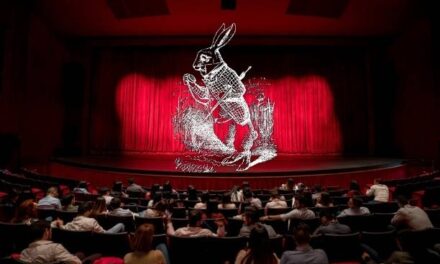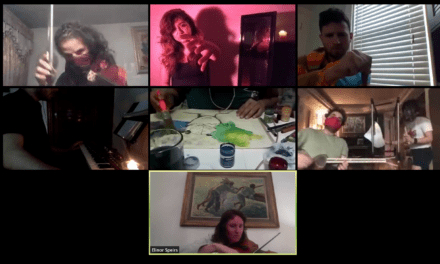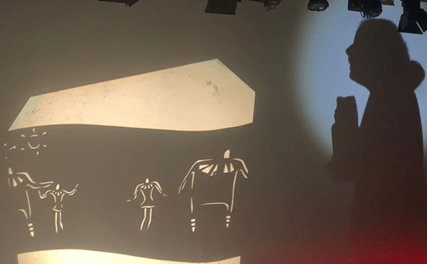The labor of sense-making
On spectatorship and the oracular potential of art
To make sense
We are constantly busy interpreting. Throughout the day, throughout our lives, we incessantly try to make sense of what happens to us. We read our surroundings to know whether it is safe to cross the street. We read other people to decipher whether they are inimical or ready to support. We read our bodily sensations to make sure we don’t eat too much or get a cold. We read our own history to contemplate whether we have made the right choice in life. We read the newspaper to build an opinion about politics. We read the clouds to have fun imagining figures and stories. Depending on our profession, we might read proton flux, grant applications, water pipes, stock market cash flow, trends, trees…
Instant by instant, immersed as we are in a vast amount of perceptions, sensations and thoughts, we filter and sort our experience in order to extract from the maze those meaningful signs that might match our involvement in the present situation and make us draw conclusions, sketch predictions and orientate our decisions. This fundamental, incessant and largely unconscious activity, is something we (presumably) share with all animals. They too are involved in a continual reading of both their inner state and their environment. Their survival depends on their accurate interpretation. It is a necessary skill to evaluate a threat, the chance to get food, the opportunity to find a shelter or the possibility to mate.
The practice of interpretation, the art of making sense, is also centrally at stake in the act of spectatorship. It is certainly the case in the field of contemporary performance whose favor for singular creations sparking plural interpretations makes the question of the spectators’ reading a beating heart of its endeavor. Anchored in the conviction that art is in the eye of the beholder, contemporary performance draws its poetics largely from exploring how the spectator composes his/her own experience, feels concerned and finally, attributes meaning. If, in the current paradigm, every artwork is a proposition of what art can be, we can also say that every artwork is a proposition of what spectatorship can be. When attending to this or that performance, how am I invited to see, feel and think? And how does it matter?
Oracles
When it comes to sense-making, oracles stand as a fascinating practice. Mainly for the inflation of sense, they imply when bridging seemingly anecdotal formal compositions (such as coffee grounds in a cup or a configuration of thrown shells) with issues that deeply matter and for which people search guidance. Here we see already how investigating oracles could tell us about art since art too relies on such inflation where objects or actions (and sometimes very simple ones) are imbued with high values, intense emotions and elaborated reflections of both personal and cultural importance.
With the term oracle, we designate various methods and disciplines aimed at interrogating a certain situation wherein mundane reasoning is thought to be insufficient or inappropriate. Oracles have always existed and been trusted across the ages and across the globe. Today, they are well and alive, even in the modern societies whose doxa officially disregards them. They are very diverse. They can work by scrutinizing contingent material features, such as the shape of a sacrificed goat liver, the pattern of your palm lines, the cracks appearing in a tortoiseshell heated in fire, or the configuration of planets in the skies on the day of your birth. They can also rely on chance to tap into an elaborate repertoire of symbols or sibylline formulas, like in Tarot, whose randomly selected cards give access to a rich iconography displayed by archetypal figures, or the I-Ching, where the repeated tossing of a coin designates a pattern of lines associated with a piece of textual wisdom (nowadays, dedicated websites powered by algorithms flourish with such oracles). Finally, an oracle could also come as a vision or a message received in an altered state of consciousness, such as in a trance of possession, a shamanic trip or simply in dreams.
Contingency, chance or altered states of consciousness; in all cases, these strategies converge to shatter the usual plane of inference. To understand how to deal with a given situation, you would normally look into this very situation. Instead, oracles make you look away from it. They make you look into some signs whose total foreignness to your issues is precisely the condition for their efficacy. Oracles interrupt the circulation of linear logic by placing an obstacle, a heterogeneous third object that triggers our deeply rooted sense of interconnectedness. They insert a caesura that challenges and intensifies our drive for unearthing relationships. To consult an oracle is to introduce a question into a milieu of diffraction, reverberation and rebound that trades on our desire to experience links. Carried away through detours, you come to be disentangled from your own concerns, so that you could envision them anew and from multiple perspectives.
Oracles thus wouldn’t be a matter of stating what will happen in the future, but a matter of unfolding the potentialities invisibly haunting the present. They undo formed opinions and disrupt established knowledge. They provoke new associations of feelings and meanings and unravel a spectrum of hitherto unforeseen possibilities. Then, eventually, an intuition about how to face the future might emerge.
SAY
Say is a translation of the Latin orare, from which the term oracle derives. Say is also the title of a one-on-one performance we are currently developing with long-term collaborators Maya Dalinsky, Anouk Llaurens, Laure Myers and Sonia Si Ahmed and with the support of Bains Connective and Zsenne art lab. Say is an artistic exploration of the principles of oracles and my basis for reflection on this matter. We do not use or adapt existing forms of oracles, rather adopt an experimental approach based on contemporary artistic strategies.
For this performance, spectators come with some personal concerns they wish to process. They get a response, offered by the performer through the use of chance, the practice of reading signs, and the embodiment of images.
Each spectator is invited to arrive at the performance with three concerns: one addressing art, another his own life, and the third, the world. While the process includes some time for the spectator to write about his concerns, they will stay forever private. The performer will never know about them. Paradoxically, the performer thus operates blindly. She delivers a response without knowing what she is responding to. The principle is that of a co-existence of clearly distinct trajectories that will progressively echo each other in the spectator’s mind and produce insights by welcoming meaningful coincidences as much as irreducible tensions. The oracle happens nowhere but in the spectator’s experience. As is true of oracles at large, the consultee (the performer here and the medium or seer in other cases) is not some sort of adviser entitled by a specific knowledge. She is the operator of a sense-making machine that provokes a proliferation of thoughts and feelings and allows meaning to emerge in the midst of buzzing interactions.
make sense, make nonsense
The response the spectator receives is based on a drawing selected from a set of six by the throw of dice. To read it, the performer uses a form of embodiment. She redraws it with eyes closed and a highly sensitive physical involvement. Doing so, she simultaneously narrates in a dreamlike state the ensuing stream of thoughts and images. The original drawing is itself overtly composite, made of traces, textures and words that do not quite form a unified image, rather display a field of relationships, a tentative constellation. As it is read while being reproduced, what at first seems to be mere formal composition unfolds in an extravagant yet surprisingly coherent narrative. A rich landscape of notions and evocations of scenes that come to resonate here and there with the spectators’ questions.
The process exhibits the labor of sense-making. The efforts, the hesitations the failures. It also shows, at times, how sense can come all in a flash. Suddenly, things fall into place. In its emergence, sense is rare but rich because it appears, still fresh, informed by its way through confusion. Reciprocally, the moments of condensation and coherence offer a perspective from which to accept and be revived by the proliferating mess of unresolved resonances. It is like a pulse, sense and nonsense appear as successive phases in a common cyclical movement. Depending on how your own phases attune to the pulse, nonsense might prove sometimes as eventful, as insightful as sense.
The interest in the pulse itself, in the incessant cross-fading of sense and nonsense, is maybe what makesSay an artistic project, whereas another form of oracle that aims at therapy or self-development might focus on how wandering through the maze gets channeled back for personal gain (a spiritually oriented practice of oracle, by contrast, could be thought of as focusing on the moment of openness, the surrender to what exceeds understanding.)
Spectatorship
Bringing into performance a format that is foreign to it puts performance, by way of frictions and contrasts, in a light where some of its taken for granted traits regain a fresh attention. Such is the case when “importing” oracle, which strikingly emphasizes habits of spectatorship.
Why do we go to see performances? How does a performance act upon us? And how do we do something out of it? The trajectory of the spectator in Say, like that of a person consulting an oracle, is one that starts prior to the performance itself. It starts at home, with the search for and choice of questions he wants to see addressed. It is also a trajectory that extends beyond the performance, as one needs to metabolize what is received, to experience its resonance in daily life. Moreover, it is a trajectory that is filtered and shaped from start to finish by the spectator’s own interest and questions, which form the initial trigger.
The usual implicit contract in performance naturally puts the emphasis on the time of the performance itself (and not its before or after), on the world the artists unravel on stage, and on the commonality of this moment of communication. A project like Say, however, works explicitly with how much a spectator (any spectator) comes to a performance (any performance) carrying his own history and concerns, how much the latter weigh in his interpretation of the piece and how much his attendance is part of a larger process. A process that includes the moment when he ponders his choice of which performance to attend and the moment after, during which the performance sill resonates, echoing here and there throughout the fabric of his life.
Thanks to the French philosopher Jacques Rancière, much has been said about the emancipated condition of the spectator. An innate emancipated condition that, far from being mere passive receivers awaiting guidance and empowerment from the performer’s action, makes spectators stand as the performer’s equal in the interpretation of the performance. Indeed, in Rancière’s view, the performance belongs no more to the artists than to the spectators and is never some transparent vehicle running unilaterally from stage to audience, bringing about some communion. It is on the contrary a third object, foreign to everyone. It has to be seized and metabolized each time, singularly, by each person’s trajectory and interest.
We are reminded of the accuracy of this perspective when working with oracles, where the spectator is but a kind of poet taking charge of the surprising correspondence and reformulation of his concerns when they meet the interpretation of the oracle.
An outcome of Rancière’s approach usually left unnoticed is that working from the premise that spectators are always already emancipated means that performers too are emancipated. Emancipated from the heavy, deadly, flattening good intention to communicate, give or help. We could then envision a contract between spectator and performer where each one recognizes and values the irreducible opacity of the other. A contract where we do not look for transparency, understanding, or even communication. A contract where performance and spectatorship are both seen as practices, interdependent indeed, yet distinct. A contract where each party is playing his own part, delving into the richness proper to his (temporary) function.
We might touch here upon the ritual dimension that oracle often implies. Rituals bring people together not for them to communicate or address something to one another. Rituals bring people together so they each contribute to opening up a liminal space (from limen: threshold, passage), an in-between where one is no longer who one was and not yet who one will be. A moment of rejuvenating indeterminacy that passes by everyone but belongs to no one.
Concerns
Today, art is increasingly expected to be concerned with the world, socio-political events, the life of the city. Moreover, it is a larger movement, one that asks every possible citizen to creatively take part in imagining a different future than the one promised by the current state of affairs.
An art project that visits oracular practices in order to question the ways we make sense of our being into the world certainly participates in such a tendency. It does so quite literally by inviting the spectators to consider their own concerns. But through that, it also addresses our concern for being concerned. Acknowledging the importance we give to feel affected by the world and to affect it, oracular processes invite to a certain way of contemplating the issues that matter to us. A way that is, paradoxically enough,impersonal. By impersonal we do not mean cold, distant or systematic. By impersonal, we mean the vibrant and rich quality of that which is deployed when we suspend our drive to identify with what affects us, to own the thoughts and feelings that occur in us. By impersonal we characterize that which rises from the acknowledgement that much of what happens in me and through me doesn’t belong to me.
But what is it for an approach? Wanting to address concerns but wanting to suspend a personal perspective? Doesn’t it lose all its edge? Isn’t it too oblique, indirect, contemplative?
Certainly, if we accept the premise that the only valid figure by which we should orient our lives is and should be the self-steered autonomous individual. If we think that changes come solely by asserting opinions, exerting will, accumulating knowledge, doing, making. But do we have to accept this narrative, so central to our contemporary societies? To refuse it and experiment with alternatives might actually prove very useful considering how much the praise of the individual is concomitant with so much isolation, so much alienation from a world that is put in danger by centuries of self-centered interest. Practices such as oracles are not in themselves a solution. But they might be creatively seized as a tool for a necessary critique. And offer ways to concretely, even if modestly, experiment with alternative approaches.
Through oracles, people of the past were making their gods participate in important debates. We don’t have such gods anymore. Our gods are dead, absent, or at least distant and mute. But never mind. The point is not how we identify and name these voices. The point is whether we are hospitable or not to such voices. To voices that are foreign to us even though they are made possible only by our own efforts. Voices that come when we suspend, even if temporarily, our pretension to be who we think we are, as individuals, as humans and as inhabitants of the world. Voices that we hear when we embrace, in a framed and rigorous way, the resources of these moments when we are not in control. Voices that we hear when we listen to our inner multiplicity, interconnectedness, porosity and opacity. Voices by which we are altered, made other, voices that make us see, feel and think in other ways, ways we wouldn’t be capable of without invoking them by our own strange practices.
With thanks to Maya Dalinsky for proofreading.
This article was originally published on http://www.e-tcetera.be/. Reposted with permission. Read the original article.
This post was written by the author in their personal capacity.The opinions expressed in this article are the author’s own and do not reflect the view of The Theatre Times, their staff or collaborators.
This post was written by Julien Bruneau.
The views expressed here belong to the author and do not necessarily reflect our views and opinions.


















